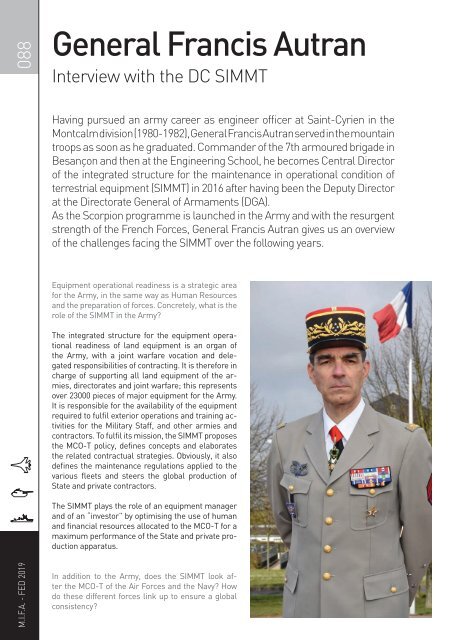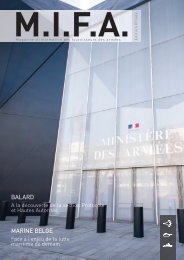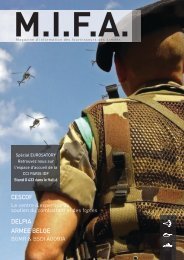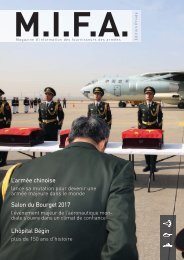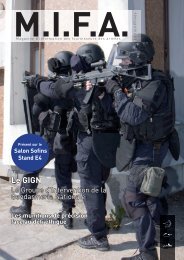FED 2019 - MIFAMAG
You also want an ePaper? Increase the reach of your titles
YUMPU automatically turns print PDFs into web optimized ePapers that Google loves.
088<br />
M.I.F.A. - <strong>FED</strong> <strong>2019</strong><br />
General Francis Autran<br />
Interview with the DC SIMMT<br />
Having pursued an army career as engineer officer at Saint-Cyrien in the<br />
Montcalm division (1980-1982), General Francis Autran served in the mountain<br />
troops as soon as he graduated. Commander of the 7th armoured brigade in<br />
Besançon and then at the Engineering School, he becomes Central Director<br />
of the integrated structure for the maintenance in operational condition of<br />
terrestrial equipment (SIMMT) in 2016 after having been the Deputy Director<br />
at the Directorate General of Armaments (DGA).<br />
As the Scorpion programme is launched in the Army and with the resurgent<br />
strength of the French Forces, General Francis Autran gives us an overview<br />
of the challenges facing the SIMMT over the following years.<br />
Equipment operational readiness is a strategic area<br />
for the Army, in the same way as Human Resources<br />
and the preparation of forces. Concretely, what is the<br />
role of the SIMMT in the Army?<br />
The integrated structure for the equipment operational<br />
readiness of land equipment is an organ of<br />
the Army, with a joint warfare vocation and delegated<br />
responsibilities of contracting. It is therefore in<br />
charge of supporting all land equipment of the armies,<br />
directorates and joint warfare; this represents<br />
over 23000 pieces of major equipment for the Army.<br />
It is responsible for the availability of the equipment<br />
required to fulfil exterior operations and training activities<br />
for the Military Staff, and other armies and<br />
contractors. To fulfil its mission, the SIMMT proposes<br />
the MCO-T policy, defines concepts and elaborates<br />
the related contractual strategies. Obviously, it also<br />
defines the maintenance regulations applied to the<br />
various fleets and steers the global production of<br />
State and private contractors.<br />
The SIMMT plays the role of an equipment manager<br />
and of an “investor” by optimising the use of human<br />
and financial resources allocated to the MCO-T for a<br />
maximum performance of the State and private production<br />
apparatus.<br />
In addition to the Army, does the SIMMT look after<br />
the MCO-T of the Air Forces and the Navy? How<br />
do these different forces link up to ensure a global<br />
consistency?<br />
The SIMMT guarantees the maintenance in operational<br />
condition of terrestrial equipment for the Army,<br />
Air Force and Navy and for the War Intendancy, the<br />
Military Fuel Service and the French Defence Health<br />
Service. We speak of logic of the environment. Every<br />
year, objectives are defined for the SIMMT by each<br />
department and the necessary financial resources<br />
are allocated. Moreover, the Navy, Air Force and Joint<br />
Warfare divisions staff are represented in the Directorate<br />
to facilitate the steering of protocols agreed<br />
between the SIMMT, delegated contractor and its<br />
own contractors.<br />
The Army ambitions to secure the maintenance in<br />
operational condition of land equipment (MCI-T) into<br />
modernity. What must we understand by modernity?<br />
Is it a change in mentality in the way of apprehending<br />
the MCO-T?<br />
The modernisation of the MCO-T has been underway<br />
since 2016 with a first phase that consisted in reorganising<br />
the sector from an organic perspective. It<br />
capitalises the transformation plans Maintenance<br />
2010 and MCO-T 2025 with the aim of improving the<br />
quality of support for our equipment relating to their<br />
service life by controlling the human and financial<br />
to be allocated. This modernisation process covers<br />
all the areas contributing to the performance of the<br />
MCO-T, i.e., the organisation, recruitment and training<br />
of staff, engineering and production processes,<br />
logistics, technical infrastructures and tools of the<br />
workshops. It exploits every opportunity offered by<br />
innovation and digital tools to gain in simplicity, reactivity,<br />
visibility and capacity of decision.<br />
This year, with the entry into force of the Military Programming<br />
law, this modernisation gathers pace to<br />
allow the MCO-T to exploit a productive model adapted<br />
to the recovery of the activity of the forces in 2024<br />
during a delicate phase of capacity transition with the<br />
arrival of the SCORPION equipment.<br />
Nothing will be done without the approval of the entire<br />
civilian and military staff. This is an undeniable<br />
factor for success. In fact, we must put ourselves in<br />
optimal conditions for success by adapting training,<br />
by adjusting the organisations and by ensuring that<br />
each one exercises their prerogatives at their level. In<br />
truth, I consider that mentalities are already turned<br />
towards modernity in our mature Army.<br />
What place is left for innovation in the MCO-T?<br />
Many MCO-T innovations emerge in the MCO-T<br />
workshops, and this has been the case for a long<br />
time. Today, we must link the modernisation of the<br />
MCO-T with innovation and digital transformation.<br />
Innovation must allow grasping every technological,<br />
methodical and managerial opportunity capable of<br />
optimising the maintenance and its logistics chain.<br />
It is not only a question of using the tools and processes<br />
that have proven their worth today to elaborate<br />
economic models, but we must also be capable<br />
of integrating flexibly mature technologies as they<br />
become accessible in all the MCO-T processes of<br />
maintenance and logistics.<br />
Digital transformation ambitions to improve productivity<br />
in our workshops through the digitalization of<br />
several actions, which is what I call “repairing more”.<br />
Using the various sensors placed on the main organs<br />
of the equipment, we must also progressively shift<br />
from preventive maintenance to projected maintenance;<br />
in other words, “repair better”, i.e., at the<br />
right need thus at the right cost, by limiting the delay<br />
of loss of use of the equipment for the various units<br />
as much as possible.<br />
The SIMMT progresses hand-in-hand with innovation,<br />
particularly thanks to the MCO LAB Terre. It<br />
imposes itself as a place for encounters between a<br />
wide range of key players, to create a tank of thinking<br />
and reflection to see the emergence of new projects<br />
responding to the needs of the forces.<br />
Can you tell us a little bit more about some of the<br />
innovative projects backed by the MCO-T?<br />
Intrinsically, our maintenance operators have a<br />
strong appetite for “the technical thing”, i.e., mastering<br />
the functioning of the equipment to increase<br />
its support. This state of mind percolates the entire<br />
MCO-T and spreads well beyond the pure technical<br />
sphere. I would like to mention three examples illustrating<br />
this culture for modernity and innovation.<br />
First of all, in the financial area, I would like to mention<br />
analytical accounting. It does not seem like<br />
much at first. But it extremely ground-breaking that<br />
the MCO should know its precise costs and to fully<br />
put the choices on offer in a perspective, particularly<br />
for finding the balance between the various industrial<br />
contractors.<br />
Then in the area of production, additive manufacturing<br />
is an emblematic and promising innovation. Experiments<br />
with this new technology are underway in<br />
France and in exterior operations. It allows making<br />
ex nihilo potentially complex spare parts. Tomorrow,<br />
this option could automatically be integrated into the<br />
design of the new equipment and their support.<br />
Finally, an information system feeds the MCO-T. Its<br />
modernisation by “both ends” is an innovation in<br />
itself. “Upwards”, by exploiting all the useful data<br />
stored inside the MCO-T’s Information System, with<br />
mathematic modelling tools relying on artificial intelligence<br />
to help in the decision-taking of support<br />
strategies and develop projected maintenance. The<br />
089<br />
M.I.F.A. - <strong>FED</strong> <strong>2019</strong>


